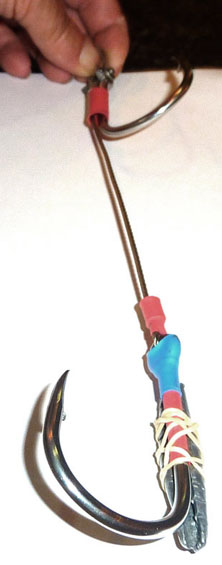Hook Positioning
By Peter Pakula - September 2010
Foreword
In this advanced series of articles, we will be exploring concepts rather than just telling you to do something one way or another. In exploring the concepts we'll be dealing mainly with how to come up with your questions and the processes involved in getting your answers.
The basic premise is that whatever you know now will most likely at some stage be proven wrong or at least a better way of doing things will become available, and that it would be best if you're the one who does that!
Some out there are achieving success rates on lures that many reject as fairy tales as they are way beyond average and perceived normal results. Most of these systems are not complex and are not hard to emulate. This series is based on trying to share so that others can also achieve better results.
The articles are long-winded yet still do not cover every aspect. Hopefully, they offer an insight into the thinking and some ways to improve results.
Article
There's no question that there are lots of ways to rig a lure, but there are points that are worth considering when deciding as to which rig to use on a lure.
This series of articles is about just that, the concepts of rigging, in this article we'll be dealing with hook positioning.
Hook and Rig Angles
We'll often mention hook angles. It's a little confusing as Game Fishing terminology doesn't use geometric angles where 00 (zero degrees) is horizontally flat as shown on a common geometric protractor.
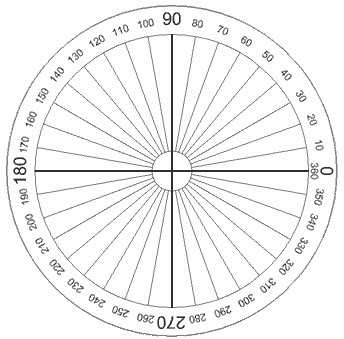
In Game Fishing terminology 00 is Vertically Straight up as shown below. The rest gets very confusing as there is a major difference in hooks in rigs as to how they are described and how they run in the water. To try and simplify things I've done a hook angle chart that we'll use to describe angles referred to in these articles.

Please review the BTL Chapter 05 Page 02: Choosing Rigs before continuing as this article to some extent carries on from there.
In most conversations people ask what lure or bait they used to catch fish when in reality you don't catch fish on either, you catch them on hooks. At least as important as getting baits and lures to perform well is getting the hook into that fish! Nothing much else matters if you can't achieve that.
Ideally, we want to control the hook as best we can and if possible aim it at the best target, which is the meat above the Jaw Bone.
By referring to the chart let's work through the angles

0 to 30 degrees: The best hook-up rates are achieved when the hook runs point up between 0 and 30 degrees. We'll call this the 'Hot Zone'
30 to 60 degrees: This angle is better than 60 to 90 degrees, but the results are not as predictable as 0 to 30 degrees.
60 to 90 degrees: Between 60 and 90 degrees the hook travels at a low angle and is more than likely to hit the upper jaw bone and won't penetrate as easily as it would be if the point rode higher towards 0 degrees.
90 degrees: At 900 or thereabout the hook is targeted at the corner of the jaw which is effective, but the fish has to turn away from the boat to be able to set the hook and if the hook is pointing the wrong way or can't roll around into position then you are looking at around 50% success rate if using a single hook in that position, higher of course with twin hooks as you have a hook pointing each way.
90 to 120 degrees: Similar to 60 and 90 degrees, if the hook travels at 90 to 120 degrees at a low angle and is more than likely to hit the lower jaw bone and won't penetrate as easily as it would if the point rode higher.
120 to 150 degrees: This angle is better than 90 to 120 degrees, but the results are not as predictable as 0 to 30 degrees or 150 to 180 degrees.
180 degrees will get the best shot at the bottom jaw, but the bottom jaw is much flatter than the top and isn't as easy a target to aim for.
Aiming at the Target
Aiming at the target is a great concept, but easier said than done! Many things are working against having control of where the point is aimed. Some of these are:
Lures
Through their natural cycle, most lures rotate. Many flip over to dive and flip again to come back to the surface. This is the case with lures of all shapes and sizes and many lures spin like a propeller.
 If this wasn't the case there'd be no need for expensive ball-bearing snap swivels which are a universal part of any lure trolling setup.
If this wasn't the case there'd be no need for expensive ball-bearing snap swivels which are a universal part of any lure trolling setup.
Lures that don't spin do have a point of balance, where one side will ride up most or all of the time. However, skirted lure heads that are commonly used today just aren't long enough or wide enough to hold enough lead to compensate for the pressures on the lure face.
Pakula Lure Ranges which are keeled include:
Paua Jets - Lead Keeled
3D Fish Prints - Air Keeled
3D Hailey's Comets - Both Air and weight keeled
Dojo Peche Hybrids where the lead is in the belly of the lure.
Skirts
Lure skirts are rarely a uniform thickness and often have a thicker and thinner side causing an imbalance in the skirt which is further exaggerated by a double thickness as with some ways of tying skirts. Often where skirts bulge out further than the lure head diameter these inconsistencies in skirt thickness will further affect the lure's stability.
Rigging
When rigged on a loose loop, on a leader with a ball bearing swivel the hook travels point up with the point of the hook in line with the eye of the hook. That is the position the hook wants to be in i.e. balanced. No matter what you do to change that the hook will always try to regain its balance. As the hook tries to regain its balance it will likely spin.
The rig also has to be centred. things like curved or bent wire or mono on the rig and the hooks not being centred will also cause the rig to spin.

The combination of the Lure and Rig
Both the lure and rig have a point of balance. If they are not matched they both balance the lure and rig will fight to gain balance and be unstable.
Where the lure is trolled
If the water is turbulent, such as in the prop wash the water tumbling will also tumble and rotate the lure and rig.
Speed
The faster you go the more critical balance is. The slower you go the more stable the rig and lure are.
All of the above factors need to be considered when choosing lures, rigs and trolling positions. I've certainly got preconceived ideas about how best to achieve lure and rig stability so that the hooks remain pointed at the target zone of 0 to 30 degrees.
There seems to be a direct correlation between success rates based on the angle of the hook point. If the hook point remains in the hot zone, success rates are high. If the points wander around the dial, the success rates seem to be the % of when the hook is in the hot zone. Ie if the lure and rig rotate and the point is only in the hot zone for 25% of the time then successful full hook-up rates are 25%.
All of these ideas come from observing lures and rigs. Unfortunately looking at lures from the back deck and bridge isn't a great way to see what is going on under the water. This is best done using trolling cameras.
Observation
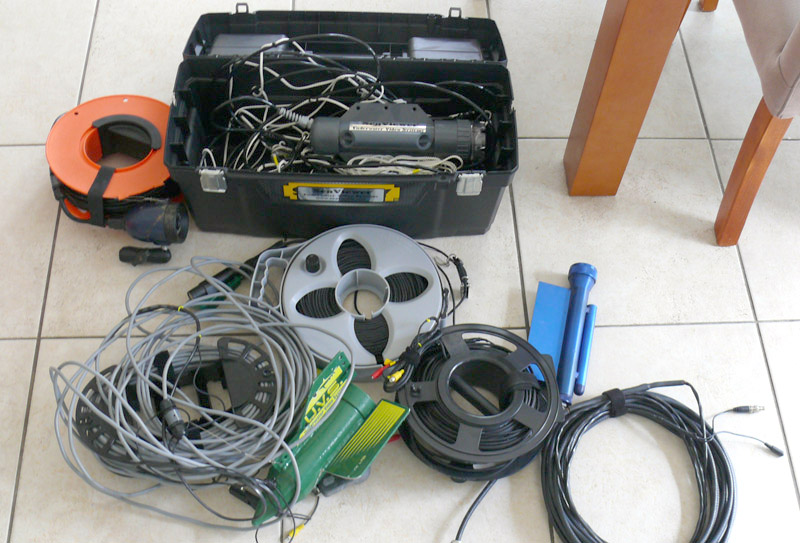 It is only in recent years that trolling cameras are stable enough to use at normal lure trolling speeds. The best I've used of the eight brands I have is a TowCam. They are expensive but pay for themselves even if you only use them to get your rigs and lures balanced.
It is only in recent years that trolling cameras are stable enough to use at normal lure trolling speeds. The best I've used of the eight brands I have is a TowCam. They are expensive but pay for themselves even if you only use them to get your rigs and lures balanced.
Another great way of observing what is going on is running lures alongside the boat in clear water off a stick or as shown in the video below where I strapped an old outrigger to the front of the bow to get a good look at rigs and lures.
You can see the flat rigger set-up at the end of the video clip: Just a quick point: when you do this have the lures and rigs connected to a proper outfit and a proper release system as things do get eaten alongside the boat ........... Take spare underpants.
I have not been able to find a way of knowing what a lure and rig are doing without using these observation methods and in the trails, there are many disappointing observations, but I have found ways to get lures and rigs to stabilise so that the point remains in the hot zone.
It is worth the effort to check each lure and rig before using it in battle. You'll find that most lures of the same brand and model are relatively consistent, but it's still worth checking each one as once you have the set-up done it doesn't take long to go through a lot of lures quickly.
If by observing your rigs, lure and lures with rigs you are happy with what you have then you are good to go. If you aren't happy here are a few points that may help:
Keeping the Hook Points in the Hot Zone
 - By letting the lure find its balance and letting the hooks find their balance you can increase their stability. Simply done by using a ball-bearing swivel in the rig. This separates the balance of the lure and rig and lets them do their own thing. Of course, use the best quality swivel you can get and the rating should be more than the leader you are using, twice the rating is fine. As with all other gear you use, check it for strength before you use it. Note the piece of heat shrink that reduces the possibility of the wire hanging on the swivel ring. The ball-bearing swivel is of most use with single hook rigs.
- By letting the lure find its balance and letting the hooks find their balance you can increase their stability. Simply done by using a ball-bearing swivel in the rig. This separates the balance of the lure and rig and lets them do their own thing. Of course, use the best quality swivel you can get and the rating should be more than the leader you are using, twice the rating is fine. As with all other gear you use, check it for strength before you use it. Note the piece of heat shrink that reduces the possibility of the wire hanging on the swivel ring. The ball-bearing swivel is of most use with single hook rigs.
 Using the ball bearing swivel allows the lure to rotate through its cycle while the hook point remains upright in the Hot Zone, To achieve that the hook bend and point need to be positioned outside the lure skirt.
Using the ball bearing swivel allows the lure to rotate through its cycle while the hook point remains upright in the Hot Zone, To achieve that the hook bend and point need to be positioned outside the lure skirt.
Shackles also allow the hooks to balance themselves. They are incredibly strong for their size, but once again check them before using them. Shackles are of most benefit when using twin hook rigs.
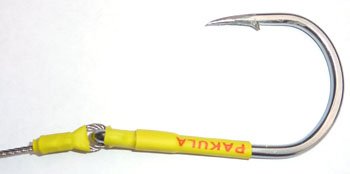 - By splitting the heat shrink on the hook eye you allow the hook to find its balance easily. Often stiff rigging of the hook eye area results in hooks spinning and lures that have a strong head shake will fatigue the wire resulting in the hook falling off, often blamed on tooth critters or tough fighting fish.
- By splitting the heat shrink on the hook eye you allow the hook to find its balance easily. Often stiff rigging of the hook eye area results in hooks spinning and lures that have a strong head shake will fatigue the wire resulting in the hook falling off, often blamed on tooth critters or tough fighting fish.
Note the heat shrink goes halfway down the loop on the wire and halfway up the hook eye. This reduces the chances of the hook hanging up on the wire loop. Use adhesive heat shrink on the hook.
If you want a stiff rig, a support such as hard heat shrink with adhesive lining or a thin garden irrigation tube should be used to support the rig. But....... once again you are restricting the action of the hook and the action of the lure. This may or may not be what you want to achieve.
- As discussed earlier speed affects the stability of the lure and rig. When you observe at the side of the boat it's important to see if your lures and rigs are stable at your higher trolling speeds. You'll find that many lures and rigs are quite stable at lower trolling speeds of 6,5 knots, but are unstable at higher speeds over 7.5 knots.
You can adjust lures actions at slower trolling speeds by adjusting the distance of the lures from the boat, the positions on the boat's pressure waves and the height the lures are trolled ie outriggers. Note that you don't have to troll lures off the tips of outriggers. The whole length of the outrigger offers adjustments from its base to its tip.
- A well-balanced twin hook rig ie the 60O shackle rig will outfish a standard single hook rig (of course this depends on balance) mainly because the two hooks have double the keel of a single hook.
An easy way to get this is to keel the rig. Below are the Pakula Keel Rig Weights.
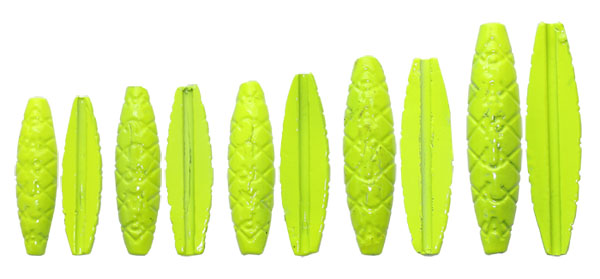
When using keels on rigs for fish that jump such as Marlin, Sails, or Dorado the keel is attached using a long skinny rubber band as shown below or bound with wax thread or something similar to ensure the weight is secured to the hook shank.

The keel sits flat halfway up the eye of the hook to stop it from rotating around the hook and you use enough wraps of the rubber band to stop the keel moving. The thin strands of the rubber band will wear through very quickly after the bite and fall off so it can't be used as a pendulum to throw the hook.
Using a keel will stabilise any skirted lure rig keeping the point in the Hot Zone. The weight of the keel is relevant and should be checked through observation, but pretty much half a 4oz barrel sinker ie 2oz will keel most rigs from 9/0 to 11/0.
So a final rig that is very stable and offers maximum hook-up rates will look like this:

The point will remain in the hot zone and allow the lure to do whatever it was designed to do. The length of the rig is important. The keel should be outside the skirt as much as practical with just the eye and the start of the keel inside the skirt.

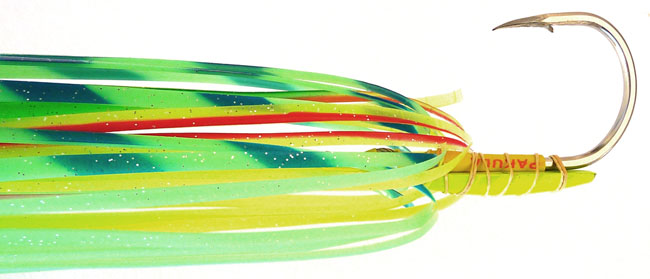
When using keels on twin hook rigs the keel is positioned so that it keels the angle you want to achieve. The image below shows a keel used on a 60-degree shackle rig where points are set at 30 degrees right and left, so the keel is set at an angle, not the bottom of the hook. Even though the 60-degree is one of the most stable rigs in rough choppy conditions where the water is turbulent the keel enhances the lure's stability.
